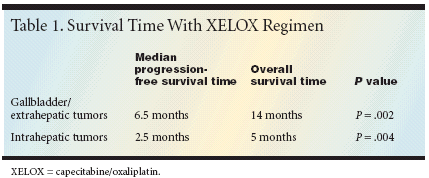XELOX Combination Is ‘Highly Active’ in Biliary System Cancers
The 30 reports in this special supplement to Oncology News International represent highlights of ongoing major clinical trials and new research presented at ASCO 2004 regarding state-of-the-art chemotherapeutic management of gastrointestinal and other cancers. Important developments in capecitabine as adjuvant therapy, novel targeted agents, and new combinations are discussed.
TUEBINGEN, Germany-Oral capecitabine (Xeloda) plus oxaliplatin(Eloxatin) is a "highly active"outpatient therapy for advanced biliarysystem adenocarcinomas, reportedOliver Nehls, MD, a postdoctoralresearch fellow, Department of InternalMedicine I, University HospitalTbingen, Germany, citing resultsfrom a phase II multicenter study (abstract4091).Outcomes were poorer in intrahepaticvs gallbladder/extrahepatic tumors,but overall, the capecitabine/oxaliplatin (XELOX) combination"has a favorable safety profile and ismore convenient than infusional regimens,avoiding the need for indwellingdevices and frequent hospital visits,"Dr. Nehls said."There's a difference in the entitieson the one hand, but on the otherhand, [XELOX is] a highly active therapyfor extrahepatic and gallbladdercarcinomas," Dr. Nehls said. Whilebiliary system carcinomas are relativelyrare, he told ONI, about 7,000 newcases are expected in the US each year.Currently, surgery is the only curativetreatment option, but most patientsare in advanced stages of the diseaseand thus unresectable. While chemotherapycan play a palliative role, nostandard-of-care treatment exists. Accordingly,Dr. Nehls and his colleagueswanted to determine the activity andtoxicity of the XELOX regimen in thispatient population.

The investigation included 58 patients(33 female, median age 63 years)who received a total of 274 cycles. Thetreatment consisted of oxaliplatin (130mg/m2, on day 1) plus capecitabine(1,000 mg/m2 twice daily, on days1-14) administered every 3 weeksfor gallbladder (22 cases), extrahepatic(20 cases), or intrahepatic (16 cases)cholangiocarcinoma.Dr. Nehls reported on 51 patientsevaluable for both response andtoxicity. Of this group, 35 patients hadgallbladder/extrahepatic disease and16 had intrahepatic disease. Completeresponses were seen in 2 patients (6%)with gallbladder/extrahepatic diseaseand no patients in the intrahepaticgroup. The overall disease control ratewas 72% for gallbladder and 82% forextrahepatic carcinoma, but only 25%for intrahepatic carcinoma. Likewise,survival was poorer in the intrahepaticgroup (see Table 1).Toxicities were generally mild; mostserious toxicities were grade 3. Themost common serious toxicities wereperipheral sensory neuropathy (eightcases grade 3, or 14%; two cases grade4, or less than 1%), and thrombocytopenia(four cases grade 3, or 1%).Two patients were discontinued fromthe study owing to allergic reactionsrelated to oxaliplatin. One patient withintrahepatic carcinoma died from sepsisafter the first treatment cycle.Previously, Dr. Nehls and colleagueshad reported on the combinationof oxaliplatin plus fluorouracil/leucovorin in patients with biliary systemcarcinomas (Br J Cancer87(7):702-704, 2002). Results of theprospective phase II showed a 56%disease control rate and a median overallsurvival time of 9.5 months.However, the XELOX regimen waschosen for this study because it hadthe potential to "improve efficacy andoffer a more convenient treatment optionfor patients," Dr. Nehls said. Toconfirm the "encouraging results" ofthis trial, a randomized study has beenplanned, he added.
How Supportive Care Methods Can Improve Oncology Outcomes
Experts discussed supportive care and why it should be integrated into standard oncology care.